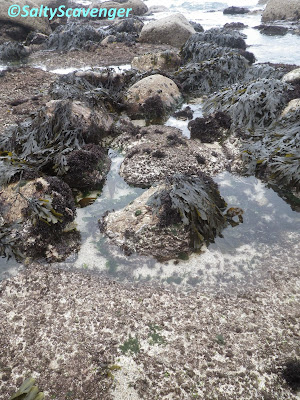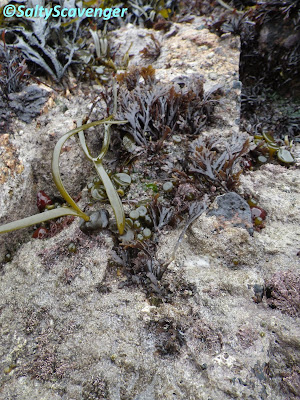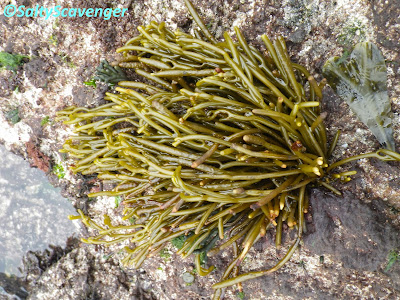The bay experiences a dynamic regime, alternating between periods of erosion and deposition. The underlying substrate is boulders and bedrock, however, variable amounts of sand may be deposited on top, sourced from the sand bar situated offshore. The communities encountered reflect the alternation between these regimes.
The shore alternates between periods of deposition (sandy) and erosion (stony).
April 2015
September 2013 January 2014
The overlaying sand has been eroded to reveal the boulders beneath. |
At the time of visitation the cove was comprised of boulders and bedrock with an occasional thin veneer of sand.
Habitat classification:
Substrate
|
LR (Littoral rock)
| ||||||||
Habitat
| LR.HLR (High energy littoral rock) |
LR.MLR (Moderate energy littoral rock)
|
LR.FLR (Features of ilttoral rock)
| ||||||
Biotope complex
|
LR.
HLR.MusB (Mussels and/or barnacles on high energy littoral rock) |
LR.MLR.BF (Barnacles and fucoids on moderately exposed shores)
|
LR.FLR.Lic.(Lichens on supralittoral and littoral fringe rock).
|
LR.FLR.Rkp (Rockpools)
|
LR.FLR.Eph (Ephemeral green or red seaweed communities
|
LR.FLR.CvoV (Littoral caves and overhangs).
| |||
Biotope
| LR.MLR.BF.Fser (Fucus serratus on moderately exposed eulittoral rock) | LR.MLR.BF.Rho (Rhodothamniella floridula on sand scoured lower eulittoral rock) |
LR.FLR.Lic.Ver (Verrucaria Maura on littoral fringe rock)
|
LR.FLR.Rkp.Cor (Coralline crust-dominated shallow eulittoral rockpools)
|
LR.FLR.Rckp.SwSed (Seaweeds in sediment- floored eulittoral rockpools).
|
LR.FLR.Eph (Ephermeral green or red seaweeds (Fresh water or sand influenced)
|
LR.FLR.Eph.EntPor (Porphyra purpurea and Entomorpha spp. on sand scoured mid to lower eulittoral rock)
| ||
Sub Biotope
| LR.MLR.BF.Fser.R (Fucus serratus and red seaweeds on moderately exposed lower eulittoral rock) |
LR.FLR.Rkp.Cor.Cor (Corallina officinalis and coralline crusts in shallow eulittoral rockpools)
| |||||||
 |
The influences of subtidal sand scour increases on the lower shore, influencing the species found. Sand scour tolerant seaweeds flourish, including the red seaweed, sand binder (Rhodothamniella floridula) and the ephemeral green Cladophora spp.
|
 |
Sand binder (Rhodothamniella floridula) can attain high abundance on the shore. Habitat classification: LR.MLR.BF.Rho (Rhodothamniella floridula on sand scoured lower eulittoral rock)
|
 |
| Rhodophtya within a sand filled rockpool of the lower shore. |
 |
| Rhodophtya within a sand filled rockpool of the lower shore. |
 |
| Rhodophtya (Polyides rotundus) within a sand filled rockpool of the lower shore. |
 |
| Ulva spp |
 |
| A sea hare (Aplysiomorpha) and anemone within a sand filled rockpool of the lower shore. |
 |
| The green seaweed, Bryopsis spp |
 |
| A juvenile crab |
 |
| Anemonia viridis |
 |
| The ephemeral green seaweed, Cladophora rupestris. |
Seaweed abundance within the sediment filled rockpools, especially that of ephemeral greens is not as extensive as observed in October, 2014. (See blog post http://thesaltyscavenger.blogspot.co.uk/2015/03/rockpooling-destination-revisit-of.html )
 |
| Grey topshell (Gibbula cineraria) |
 |
Eventually Fucus cover gives way to robust reds and Himanthalia elongata. Habitat classification: LR.HLR.FR (Robust fucoids and/or red seaweed communities) EUNIS: A1.12.
|
 |
| Corallina officinalis forms a turf on the bedrock with robust reds, Himanthalia elongata and Laminaria spp. |
 |
| Corallina officinalis forms a turf on the bedrock. |
 |
| Mastrocarpus stellatus, Rhodothamniella floridula, Laminaria spp and Himnathlia elongata. |
|
 |
| A turf of robust reds, dominated by Mastrocarpus stellatus, Laminaria spp and Himnathlia elongata. |
 |
| Himnathlia elongata. |
 |
| Edible crab (Cancer pagurus) |
 |
| Corallinaceae crusts occur within and extend beyond the rockpools of the cave entrance due to the shade provided by the overhanging cliff. |
Cladophora spp and Coralinaceae crusts live in the shaded entrance of the sea cave.
 |
| Corallinaceae crusts occur within a rockpool of the cave cliff edge. |















No comments:
Post a Comment